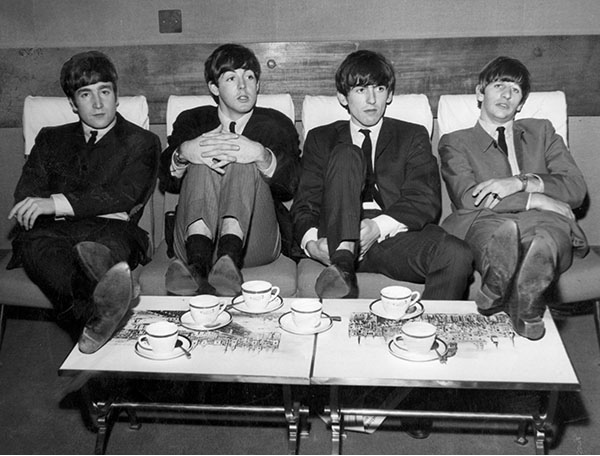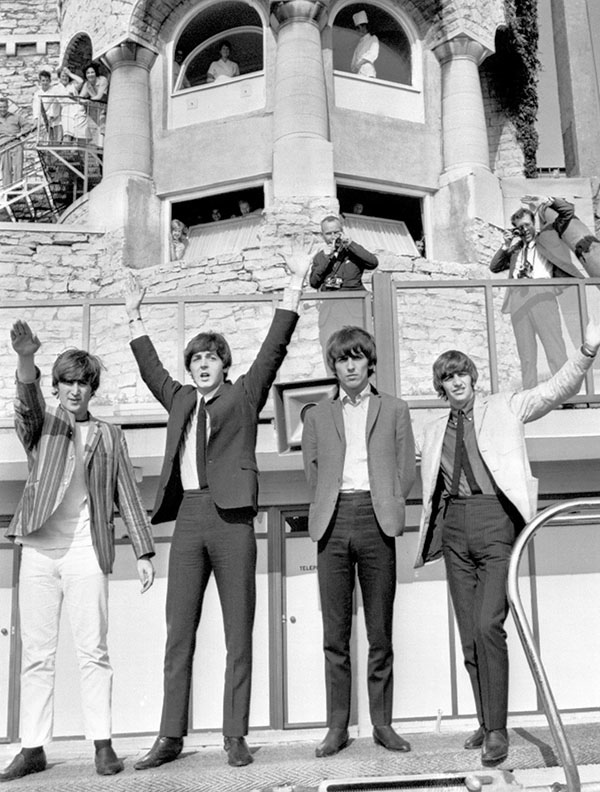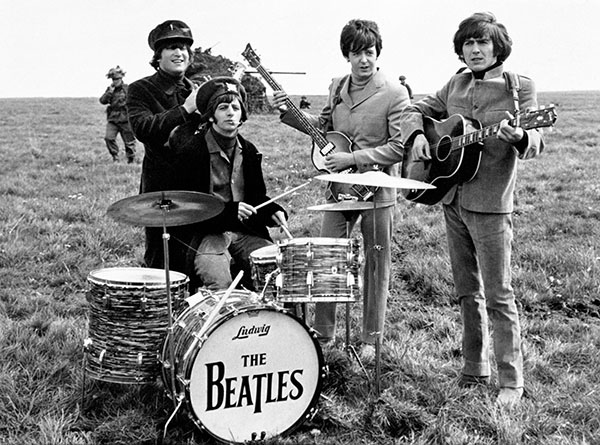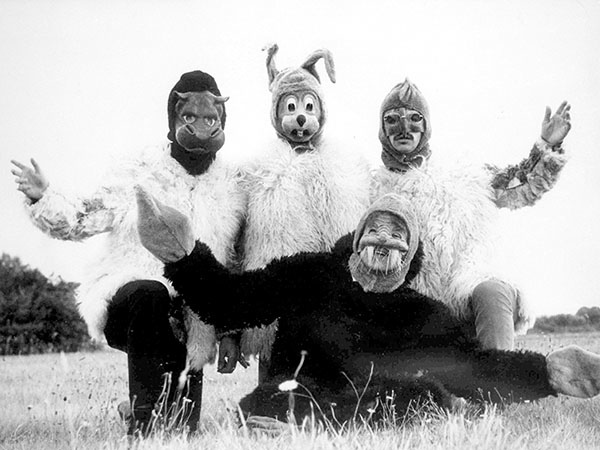Across the Universe
Since their February 1964 appearance on the Ed Sullivan Show, the Beatles have influenced the world with more than just their music.
by Larry Weisman

In 1963 and 1964, the Beatles’ popularity grew to a frenzy.

Here the Fab Four wave to adoring fans after they climbed up the diving board at a Stockholm hotel pool.
They made “wooo” a lyric. They turned “yeah, yeah, yeah” into acceptable English. Meet the Beatles? I believe you’re already acquainted. And of all these friends and lovers, none compare. The Beatles entered our lives and lit them up. Kids engulfed hotels that housed the Fab Four, filled arenas, appeared wild-eyed and bursting with furious passion in TV accounts of Beatles sightings. And so Beatlemania began on this side of the pond. A European madness ripped across our shores.
Boys grew their hair out and walked saucily with bangs shading foreheads previously exposed by styles such as Elvis’s pompadour. The tailoring of suits grew narrower as our eyes grew wider. Girls swooned, sighed and overlaid the cheeky lads from Liverpool with personalities and attributes they desired.

In 1965, the Beatles showed more maturity and complexity in their music, especially with the album Rubber Soul.
Beatles Domination
The Fab Four put Liverpool on the map and began the British Invasion, altering the music scene and culture forever. The Rolling Stones, The Dave Clark Five, Gerry and the Pacemakers, Peter and Gordon, Herman’s Hermits, The Who, all surfed a Beatles-inspired wave that roiled the Atlantic Ocean. Rock ’n’ roll, which had its roots in American rhythm and blues, bowed to the Union Jack.
The Beatles dominated radio, with 27 No. 1 hits in the U.S. and U.K., and many of those were not even their most critically acclaimed works. Meanwhile, their worldwide travels and travails made news … and television ate it up.
From modest beginnings are such events born. I sat transfixed in 1964, focused furiously on the tiny television screen in front of me, as Ed Sullivan, the preposterously stiff talent impresario who owned Sunday nights, introduced the Beatles to America before a live, screaming audience. They played, they sang, and the world changed.
Well, most of it. My father wasn’t buying whatever the “mop tops” were selling, and I became a rarity in my elementary school — a kid who still had a parentally mandated crewcut. I only amplified this apparent sense of obtuseness by sticking with clarinet lessons, instead of switching, as so many of my friends did, to guitar.
I never mastered the clarinet. I ultimately learned the guitar. I will not be releasing any recordings of my performances with either instrument. But learning to play “Blackbird” on my Gibson sunburst acoustic (a 1969 model that is still in my possession) was one of my proudest moments.
Everything went Beatles. Shea Stadium, home of the New York Mets, became the site of an extraordinarily short concert in which the band found itself unable to hear its music due to the noise from the crowd. They never again played before as many as the 55,000 who packed Shea. New York went Beatles, with a disk jockey named Murray the K (Kaufman) styling himself as the Fifth Beatle. There were Beatles trading cards, pins, wigs, a cartoon series, manic and madcap movies. There were manufactured imitators who were made for TV (The Monkees) and moral opposites (the bad-boy Rolling Stones, of course).
Changing Times
As the Beatles grew and matured (they were really just teenagers when the craziness hit), their work mapped the pattern of a generation’s development. Goofy, mushy teen love (“I Wanna Hold Your Hand”). A little deeper passion (“P.S. I Love You”). Introspection (“Yesterday”). The weird, vague sense that life might not be a cheery bounce free of misery and loneliness (“Eleanor Rigby”). Hazy, trippy mental gymnastics (“Within You and Without You”).
They brought us the sitar and Ravi Shankar (who bequeathed us Norah Jones, bless him). They introduced us to religions and philosophies we’d never experienced when they traveled to India to study transcendental meditation with the Maharishi Mahesh Yogi. They irritated Christians worldwide with John Lennon’s proclamation that the Beatles were more popular than Jesus. They preached love but sometimes, in the case of nut jobs like the murderous Charles Manson (“Helter Skelter”), they got blamed for violence. The Beatles could be whatever you thought they were, and sometimes whatever they thought they were (alternative personalities in Sgt. Pepper’s, cartoon characters in Yellow Submarine).
Did we mention drugs? Mind expansion, LSD (“Lucy in the Sky with Diamonds”), other forms of substance abuse? The times practically demanded it, but the Beatles helped foment it.
The Beatles introduced in-fighting due to a celebrity marriage (Lennon and Yoko Ono). The band broke up. The Fab Four went their separate ways, got back together for a rooftop farewell concert, and again went their own ways. In a sense, they led us through our adolescence, our marriages, divorces and journeys to self-discovery. They were political (John and Yoko’s Bed-In for Peace in 1969 in Amsterdam and Montreal) and anti-political (Revolution).
It’s been 50 years since the Beatles shook those mod haircuts on American TV and set off their own revolution. Now they’re scenery, background music heard in elevators, the soundtrack of our lives. The smart one, John Lennon, was shot and killed by a crazed fan in 1980. The cute one, Sir Paul McCartney, thrives in his 70s and still makes music. The quiet one, George Harrison, died of cancer in 2001. Ringo Starr, the funny one, received the French Medal of Honor in September 2013 and continues to play music and indulge a passion for photography.
Two are gone, but they, as the Beatles, endure.
Try this exercise. Ask someone to name his or her favorite Beatles’ song. Now ask someone else. See how long it takes before the same song is mentioned twice.
“Michelle.” “Penny Lane.” “Hey Jude.” “Eleanor Rigby.” “Here Comes the Sun.” “Something.” “A Day in the Life.” “Here, There and Everywhere.” “Let It Be.” “Ticket to Ride.” The canon goes on and on. The Beatles go on and on.
As for me, I believe in “Yesterday.”

The Fab Four donned animal costumes for their 1967 television fantasy show, “Magical Mystery Tour.”
Journalist and author Larry Weisman has listened to the Beatles on vinyl, 8-track tapes, cassette tapes, CDs and via streaming audio. His favorite of the Fab Four was George Harrison.